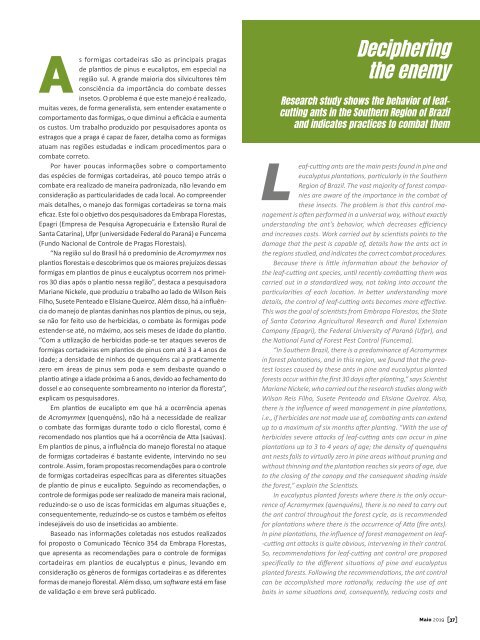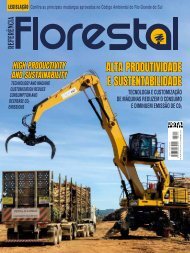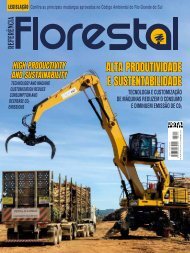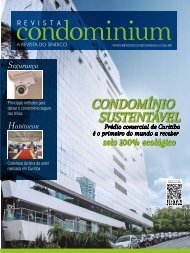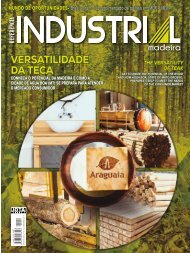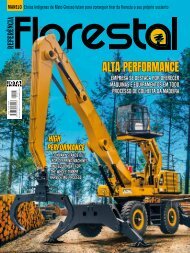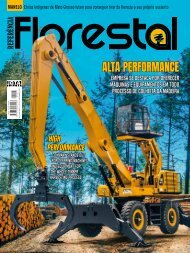*Maio / 2019 - Referência Florestal 207
Create successful ePaper yourself
Turn your PDF publications into a flip-book with our unique Google optimized e-Paper software.
As formigas cortadeiras são as principais pragas<br />
de plantios de pinus e eucaliptos, em especial na<br />
região sul. A grande maioria dos silvicultores têm<br />
consciência da importância do combate desses<br />
insetos. O problema é que este manejo é realizado,<br />
muitas vezes, de forma generalista, sem entender exatamente o<br />
comportamento das formigas, o que diminui a eficácia e aumenta<br />
os custos. Um trabalho produzido por pesquisadores aponta os<br />
estragos que a praga é capaz de fazer, detalha como as formigas<br />
atuam nas regiões estudadas e indicam procedimentos para o<br />
combate correto.<br />
Por haver poucas informações sobre o comportamento<br />
das espécies de formigas cortadeiras, até pouco tempo atrás o<br />
combate era realizado de maneira padronizada, não levando em<br />
consideração as particularidades de cada local. Ao compreender<br />
mais detalhes, o manejo das formigas cortadeiras se torna mais<br />
eficaz. Este foi o objetivo dos pesquisadores da Embrapa Florestas,<br />
Epagri (Empresa de Pesquisa Agropecuária e Extensão Rural de<br />
Santa Catarina), Ufpr (universidade Federal do Paraná) e Funcema<br />
(Fundo Nacional de Controle de Pragas Florestais).<br />
“Na região sul do Brasil há o predomínio de Acromyrmex nos<br />
plantios florestais e descobrimos que os maiores prejuízos dessas<br />
formigas em plantios de pinus e eucalyptus ocorrem nos primeiros<br />
30 dias após o plantio nessa região”, destaca a pesquisadora<br />
Mariane Nickele, que produziu o trabalho ao lado de Wilson Reis<br />
Filho, Susete Penteado e Elisiane Queiroz. Além disso, há a influência<br />
do manejo de plantas daninhas nos plantios de pinus, ou seja,<br />
se não for feito uso de herbicidas, o combate às formigas pode<br />
estender-se até, no máximo, aos seis meses de idade do plantio.<br />
“Com a utilização de herbicidas pode-se ter ataques severos de<br />
formigas cortadeiras em plantios de pinus com até 3 a 4 anos de<br />
idade; a densidade de ninhos de quenquéns cai a praticamente<br />
zero em áreas de pinus sem poda e sem desbaste quando o<br />
plantio atinge a idade próxima a 6 anos, devido ao fechamento do<br />
dossel e ao consequente sombreamento no interior da floresta”,<br />
explicam os pesquisadores.<br />
Em plantios de eucalipto em que há a ocorrência apenas<br />
de Acromyrmex (quenquéns), não há a necessidade de realizar<br />
o combate das formigas durante todo o ciclo florestal, como é<br />
recomendado nos plantios que há a ocorrência de Atta (saúvas).<br />
Em plantios de pinus, a influência do manejo florestal no ataque<br />
de formigas cortadeiras é bastante evidente, intervindo no seu<br />
controle. Assim, foram propostas recomendações para o controle<br />
de formigas cortadeiras específicas para as diferentes situações<br />
de plantio de pinus e eucalipto. Seguindo as recomendações, o<br />
controle de formigas pode ser realizado de maneira mais racional,<br />
reduzindo-se o uso de iscas formicidas em algumas situações e,<br />
consequentemente, reduzindo-se os custos e também os efeitos<br />
indesejáveis do uso de inseticidas ao ambiente.<br />
Baseado nas informações coletadas nos estudos realizados<br />
foi proposto o Comunicado Técnico 354 da Embrapa Florestas,<br />
que apresenta as recomendações para o controle de formigas<br />
cortadeiras em plantios de eucalyptus e pinus, levando em<br />
consideração os gêneros de formigas cortadeiras e as diferentes<br />
formas de manejo florestal. Além disso, um software está em fase<br />
de validação e em breve será publicado.<br />
Deciphering<br />
the enemy<br />
Research study shows the behavior of leafcutting<br />
ants in the Southern Region of Brazil<br />
and indicates practices to combat them<br />
L<br />
eaf-cutting ants are the main pests found in pine and<br />
eucalyptus plantations, particularly in the Southern<br />
Region of Brazil. The vast majority of forest companies<br />
are aware of the importance in the combat of<br />
these insects. The problem is that this control management<br />
is often performed in a universal way, without exactly<br />
understanding the ant’s behavior, which decreases efficiency<br />
and increases costs. Work carried out by scientists points to the<br />
damage that the pest is capable of, details how the ants act in<br />
the regions studied, and indicates the correct combat procedures.<br />
Because there is little information about the behavior of<br />
the leaf-cutting ant species, until recently combatting them was<br />
carried out in a standardized way, not taking into account the<br />
particularities of each location. In better understanding more<br />
details, the control of leaf-cutting ants becomes more effective.<br />
This was the goal of scientists from Embrapa Florestas, the State<br />
of Santa Catarina Agricultural Research and Rural Extension<br />
Company (Epagri), the Federal University of Paraná (Ufpr), and<br />
the National Fund of Forest Pest Control (Funcema).<br />
“In Southern Brazil, there is a predominance of Acromyrmex<br />
in forest plantations, and in this region, we found that the greatest<br />
losses caused by these ants in pine and eucalyptus planted<br />
forests occur within the first 30 days after planting,” says Scientist<br />
Mariane Nickele, who carried out the research studies along with<br />
Wilson Reis Filho, Susete Penteado and Elisiane Queiroz. Also,<br />
there is the influence of weed management in pine plantations,<br />
i.e., if herbicides are not made use of, combating ants can extend<br />
up to a maximum of six months after planting. “With the use of<br />
herbicides severe attacks of leaf-cutting ants can occur in pine<br />
plantations up to 3 to 4 years of age; the density of quenquéns<br />
ant nests falls to virtually zero in pine areas without pruning and<br />
without thinning and the plantation reaches six years of age, due<br />
to the closing of the canopy and the consequent shading inside<br />
the forest,” explain the Scientists.<br />
In eucalyptus planted forests where there is the only occurrence<br />
of Acromyrmex (quenquéns), there is no need to carry out<br />
the ant control throughout the forest cycle, as is recommended<br />
for plantations where there is the occurrence of Atta (fire ants).<br />
In pine plantations, the influence of forest management on leaf-<br />
-cutting ant attacks is quite obvious, intervening in their control.<br />
So, recommendations for leaf-cutting ant control are proposed<br />
specifically to the different situations of pine and eucalyptus<br />
planted forests. Following the recommendations, the ant control<br />
can be accomplished more rationally, reducing the use of ant<br />
baits in some situations and, consequently, reducing costs and<br />
Maio <strong>2019</strong><br />
37


